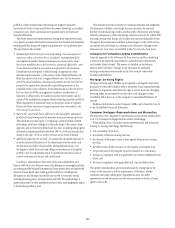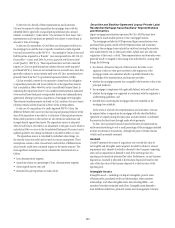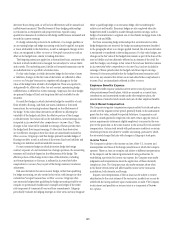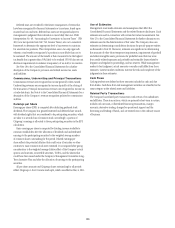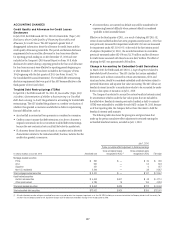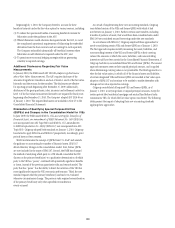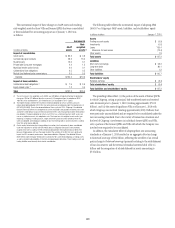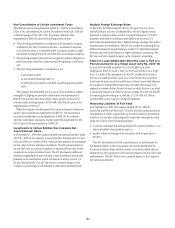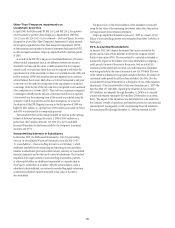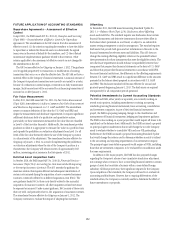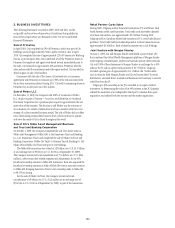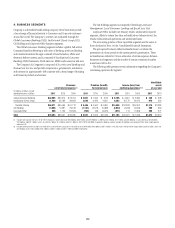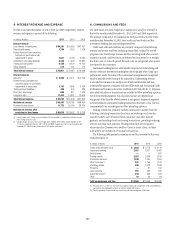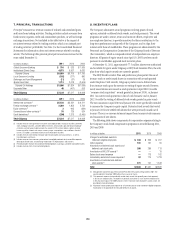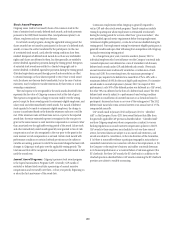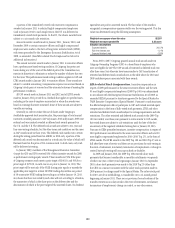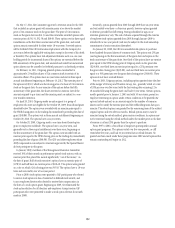Citibank 2011 Annual Report Download - page 174
Download and view the complete annual report
Please find page 174 of the 2011 Citibank annual report below. You can navigate through the pages in the report by either clicking on the pages listed below, or by using the keyword search tool below to find specific information within the annual report.152
FUTURE APPLICATION OF ACCOUNTING STANDARDS
Repurchase Agreements – Assessment of Effective
Control
In April 2011, the FASB issued ASU No. 2011-03, Transfers and Servicing
(Topic 860) – Reconsideration of Effective Control for Repurchase
Agreements. The amendments in the ASU remove from the assessment of
effective control: (1) the criterion requiring the transferor to have the ability
to repurchase or redeem the financial assets on substantially the agreed
terms, even in the event of default by the transferee, and (2) the collateral
maintenance implementation guidance related to that criterion. Other
criteria applicable to the assessment of effective control are not changed by
the amendments in the ASU.
The ASU became effective for Citigroup on January 1, 2012. The guidance
is to be applied prospectively to transactions or modifications of existing
transactions that occur on or after the effective date. The ASU did not have a
material effect on the Company’s financial statements. A nominal amount of
the Company’s repurchase transactions are currently accounted for as sales,
because of a reduction in initial margin or restriction in daily maintenance
margin. Such transactions will be accounted for as financing transactions if
executed on or after January 1, 2012.
Fair Value Measurement
In May 2011, the FASB issued ASU No. 2011-04, Fair Value Measurement
(Topic 820): Amendments to Achieve Common Fair Value Measurement
and Disclosure Requirements in U.S. GAAP and IFRS. The amendment
creates a common definition of fair value for U.S. GAAP and IFRS and
aligns the measurement and disclosure requirements. It requires significant
additional disclosures both of a qualitative and quantitative nature,
particularly on those instruments measured at fair value that are classified
in Level 3 of the fair value hierarchy. Additionally, the amendment provides
guidance on when it is appropriate to measure fair value on a portfolio basis
and expands the prohibition on valuation adjustments from Level 1 to all
levels of the fair value hierarchy where the size of the Company’s position
is a characteristic of the adjustment. The amendment became effective for
Citigroup on January 1, 2012. As a result of implementing the prohibition
on valuation adjustments where the size of the Company’s position is a
characteristic, the Company will release reserves of approximately $125
million, increasing pretax income in the first quarter of 2012.
Deferred Asset Acquisition Costs
In October 2010, the FASB issued ASU No. 2010-26, Financial Services –
Insurance (Topic 944): Accounting for Costs Associated with Acquiring
or Renewing Insurance Contracts. The ASU amends the guidance for
insurance entities that requires deferral and subsequent amortization of
certain costs incurred during the acquisition of new or renewed insurance
contracts, commonly referred to as deferred acquisition costs (DAC). The
new guidance limits DAC to those costs directly related to the successful
acquisition of insurance contracts; all other acquisition-related costs must
be expensed as incurred. Under current guidance, DAC consists of those costs
that vary with, and primarily relate to, the acquisition of insurance contracts.
The amendment became effective for Citigroup on January 1, 2012. The
Company continues to evaluate the impact of adopting this statement.
Offsetting
In December 2011, the FASB issued Accounting Standards Update No.
2011-11—Balance Sheet (Topic 210): Disclosures about Offsetting
Assets and Liabilities. The standard requires new disclosures about certain
financial instruments and derivative instruments that are either offset in
the balance sheet (presented on a net basis) or subject to an enforceable
master netting arrangement or similar arrangement. The standard requires
disclosures that provide both gross and net information in the notes to the
financial statements for relevant assets and liabilities. This ASU does not
change the existing offsetting eligibility criteria or the permitted balance
sheet presentation for those instruments that meet the eligibility criteria. The
new disclosure requirements should enhance comparability between those
companies that prepare their financial statements on the basis of U.S. GAAP
and those that prepare their financial statements in accordance with IFRS.
For many financial institutions, the differences in the offsetting requirements
between U.S. GAAP and IFRS result in a significant difference in the amounts
presented in the balance sheets prepared in accordance with U.S. GAAP
and IFRS. The disclosure standard will become effective for annual and
quarterly periods beginning January 1, 2013. The disclosures are required
retrospectively for all comparative periods presented.
Potential Amendments to Current Accounting Standards
The FASB and IASB, either jointly or separately, are currently working on
several major projects, including amendments to existing accounting
standards governing financial instruments, lease accounting, consolidation
and investment companies. As part of the joint financial instruments
project, the FASB is proposing sweeping changes to the classification and
measurement of financial instruments, hedging and impairment guidance.
The FASB is also working on a joint project that would require all leases to be
capitalized on the balance sheet. Additionally, the FASB has issued a proposal
on principal-agent considerations that would change the way the Company
needs to evaluate whether to consolidate VIEs and non-VIE partnerships.
Furthermore, the FASB has issued a proposed Accounting Standards Update
that would change the criteria used to determine whether an entity is subject
to the accounting and reporting requirements of an investment company.
The principal-agent consolidation proposal would require all VIEs, including
those that are investment companies, to be evaluated for consolidation under
the same requirements.
In addition to the major projects, the FASB has also proposed changes
regarding the Company’s release of any cumulative translation adjustment
into earnings when it ceases to have a controlling financial interest in certain
groups of assets that constitute a business within a consolidated foreign
subsidiary. All these projects may have significant impacts for the Company.
Upon completion of the standards, the Company will need to re-evaluate its
accounting and disclosures. However, due to ongoing deliberations of the
standard-setters, the Company is currently unable to determine the effect of
future amendments or proposals.


